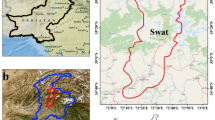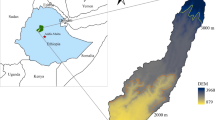Abstract
The Maiji District of Tianshui City (Gansu Province, China) is a typical transition region in the ecotone between the Loess Plateau and the Western Qinling Mountains. Exploring the spatiotemporal dynamics of soil erosion in this ecotone is critical for the scientific and impactive mitigation of soil erosion hazards in this ecologically fragile region. With geographic information system (GIS) and remote sensing (RS), we used the revised universal soil loss equation (RUSLE) model to assess soil erosion in the Maiji District and analyzed its dynamic changes between the years 2000, 2005, 2010, and 2015. We also derived a minimum erosion cell for the study region to assess the impacts of different factors upon soil erosion. Our results showed that total soil losses in the study region changed from 2000 to 2015, being steady initially, then increasing, and finally decreasing. Among different erosion classes, slight to light erosion was the most prevalent form, while areas under moderate to higher classes of soil erosion shifted towards a lower class over time. In each year, soil loss consistently increased before it decreased with an increasing class of elevation and slope (respectively, 1500 m a.s.l. and 30° as critical thresholds). However, notable differences were evident between years in soil loss trends with varying classes of vegetation coverage and rainfall erosivity; vegetation coverage could mitigate the adverse impact of rainfall erosivity and thus constrain soil erosion hazards. In conclusion, the situation of soil erosion exhibited an overall trend of improvement in the transition region of the Maiji District. While topography determines the basic pattern of soil erosion occurrence, interactions between vegetation coverage and rainfall erosivity drive the dynamic development of soil erosion in our study region. Since vegetation coverage is a manageable factor, its reasonable and responsible regulation presents an effective way to mitigate soil erosion hazards in this region of China.






Similar content being viewed by others
References
Angima SD, Stott DE, O’Neill MK, Ong CK, Weesies GA (2003) Soil erosion prediction using RUSLE for central Kenyan highland conditions. Agric Ecosyst Environ 97(1–3):295–308
Benchettouh A, Kouri L, Jebari S (2017) Spatial estimation of soil erosion risk using RUSLE/GIS techniques and practices conservation suggested for reducing soil erosion in Wadi Mina watershed (northwest, Algeria). Arab J Geosci 10(4):79
Beven KJ, Kirkby MJ (1979) A physically based, variable contributing area model of basin hydrology. Int Assoc Sci Hydrol Bull 24(1):43–69
Bhandari K, Aryal J, Darnsawasdi R (2015) A geospatial approach to assessing soil erosion in a watershed by integrating socio-economic determinants and the RUSLE model. Nat Hazards 75:321–342
Chen YB, Liang HM, Yu WH et al (2015) The characteristics of spatial-temporal differentiation of soil erosion based on RUSLE model: a case study of Chaoyang City, Liaoning Province. Entia Geogr Sin 35(3):365–372
De Roo APJ, Hazelhoff L, Burrouph PA (1989) Soil erosion modeling using ANSWERS and geographical information systems. Earth Surf Process Landf 14:517–532
Deng ZQ, Li MJ, Jung HS (2009) Sediment transport rate-based model for rainfall induced soil erosion. Catena. 76:54–62
Diodato N (2004) Estimating RUSLE’s rainfall factor in the part of Italy with a Mediterranean rainfall regime. Hydrol Earth Syst Sci 8(1):103–107
Fu SH, Liu BY (2002) Evolution of the soil erosion model. Adv Earth Science 17(1):78–84
Guo B, Tao HP, Liu BT, Jiang L (2012) Characteristics and analysis of soil erosion in Li country after Wenchuan earthquake based on GIS and USLE. Trans Chin Soc Agric Eng 28(14):118–126
Hu KZ (2016) Spatial-temporal changes of soil erosion of different bioclimatic zones in the Loess Plateau. Yangtze River 47(13):16–23
Hu LJ, Yang HJ, Yang QK (2010) A GIS-based modeling approach for fast assessment of soil erosion by water at regional scale, loess plateau of China. Chin Geogr Sci 20(5):423–433
Jiang ZS, Li XY (1988) Study on the rainfall erosivity and the topographic factor of predicting soil loss equation in the Loess Plateau. Memoir Northwestern Inst Soil Water Convers Acad Sin 6(7):40–45
Jiang ZS, Wang ZQ, Liu Z (1996) Study on the use of GIS to estimate soil erosion in a small watershed in the Loess Hilly Region. Research of Soil & Water Conservation 3(2):84–97
Lane LJ, Renard KG, Foster GR, Laflen J (1992) Development and application of modern soil erosion prediction technology-The USDA experience. Soil Res 30(6):893–912
Li Y, Bai X, Zhou Y, Qin L, Tian X, Tian Y, Li P et al. (2016) Spatial–temporal evolution of soil erosion in a typical mountainous karst basin in SW China, based on GIS and RUSLE. Arab J Sci Eng 41(1):209–221
Liu BY, Zhang KL, Xie Y (2002) An empirical soil loss equation. Proc of 12th ISCO. Tsingh, ua Press, Beijing, pp 143–149
Lu JZ, Chen XL, Li H et al (2011) Soil erosion changes based on GIS/RS and USLE in Poyang Lake basin. Trans CSAE 27(2):337–334
Meshesha DT, Tsunekawa A, Tsubo M, Haregeweyn N (2012) Dynamics and hotspots of soil erosion and management scenarios of the central rift valley of Ethiopia. Int J Sediment Res 27(1):84–99
Minwer Alkharabsheh M, Alexandridis T, Misopolinos N, Bilas G, Syllaios N (2013) Impact of land cover change on soil erosion hazard in northern Jordan using remote sensing and GIS. Procedia Environ Sci 19(12):912–921
Moges DM, Bhat HG (2017) Integration of geospatial technologies with RUSLE for analysis of land use/cover change impact on soil erosion: case study in rib watershed, north-western highland Ethiopia. Environ Earth Sci 76(22):765
Morgan RPC, Quinton JN, Smith RE et al (2015) The European soil erosion model (EUROSEM): a dynamic approach for predicting sediment transport from fields and small catchments. Earth Surf Process Landf 23(6):527–544
Mou JZ, Meng QM (1983) Preliminary study on prediction equation of soil erosion by rainfall erosion. Soil Water Conserv China 6(9):23–26
Nearing MA, Foster GR, Lane LJ, Finkner SCA (1989) A process-based soil erosion model for USDA-water erosion prediction project technology. Trans ASAE 32(5):1587–1593
Pan MH, Wu YQ, Ren FP (2010) Estimating soil erosion in the Dongjiang River Basin based on USLE. J Nat Resour 25(12):2154–2164
Paola FD, Ducci D, Giugni M (2013) Desertification and erosion sensitivity-a case study in southern Italy: the Tusciano river catchment. Environ Earth Sci 70(5):2179–2190
Peng J, Li DD, Zang YQ (2007) Analysis of spatial characteristics of soil Erosion in mountain area of north western Yunnan based on GIS and RUSLE. J Mt Sci 25(5):548–556
Rejani R, Rao KV, Osman M et al (2016) Spatial and temporal estimation of soil loss for the sustainable management of a wet semi-arid watershed cluster. Environ Monit Assess 188(3):143.1–143.16
Renard KG, Foster GR, Weesies GA et al (1997) Soil erosion by water—a guide to conservation planning with the Revised Universal Soil Loss Equation (RUSLE). In: Agriculture handbook no. 703, USDA-ARS
Shi PJ, Liu BY, Zhang KL (1999) Soil erosion process and model studies. Resource Sci 21(5):9–18
Sumudu S, Biswajeet P, Alfredo H, Jane B (2020) Assessing soil erosion hazards using land-use change and landslide frequency ratio method: a case study of Sabaragamuwa Province Sri Lanka. Remote Sens 12:1483
Toubal AK, Achite M, Ouillon S, Dehni A (2018) Soil erodibility mapping using the RUSLE model to prioritize erosion control in the Wadi Sahouat basin north-west of Algeria. Environ Monit Assess 190(4):210
Wang K, Xia YQ, Ma JH, Qu C (2015) Quantitative assessment of soil erosion in Gushanchuan watershed based on CSLE and high-resolution aerial images. Res Soil Water Conserv 01:26–32
Wang LN, Li WL, Wang SF et al (2016) Variation in soil erosion based on USLE model and remote sensing technology during 2000-2010 in Gansu Province. Pratacult Sci 33(2):176–183
Wen Y, Liu XN, Cheng J (2013) Assessment and feature analysis of soil erosion in mountainous area of Guangdong Province on USLE. Bull Soil Water Conserv 33(4):112–118
Williams JR, Jones CA, Dyke PT (1984) A modeling approach to determining the relationship between erosion and soil productivity. Trans ASAE 27(1):129–144
Wischmeier W, Smith D (1965) Predicting rainfall erosion losses from cropland east of the Rocky Mountains. In: Agriculture Handbook 282. USDA-ARS, Washington, DC
Wischmeier WH, Smith DD (1978) Predicting rainfall erosion losses—a guide to conservation planning. USDA Agriculture Handbook, vol 537. GPO, Washington DC
Xie HX (2008) Study on the spatio-temporal change of soil loss and on the assessment of impacts on environment of soil and water conservation in Yanhe basin. Doctoral dissertation, Shan Xi Normal University, Xian, Shanxi, China
Yang J, Ge JP, Li QB (2006) Predicting soil erosion rates of small watersheds in the Wolong area based on USLE and GIS. J Tsinghua Univ (Sci Technol) 46(99):1526–1529
Zhang WB, Xie Y, Liu BY (2002) Rainfall erosivity estimation using daily rainfall amounts. Entia Geogr Sin 22(6):705–711
Zhao HG, Tang YY, Yang ST (2018) Dynamic identification of soil erosion risk in the middle reaches of the Yellow River Basin in China from 1978 to 2010 J. J Geogr Sci 28(002):175–192
Zheng FL, Wang ZL, Yang QK (2007) The retrospection and prospect on soil erosion research in China. Chin J Nat 30(1):12–16
Zhou MS, Li DH, Zhang GL (2016) Dynamic evolution and prediction of soil erosion in Anhui Province from 1980 to 2010. Soils 48(3):588–596
Zhu MY, Tan SD, Zhang QF (2013) Assessment of soil erosion based on GIS and USLE in a small agriculture watershed. China Resource Environ Yangtze Basin 22(12):1564–1572
Funding
This research was supported by the National Natural Science Foundation of China (31160269, 31571594).
Author information
Authors and Affiliations
Corresponding author
Additional information
Responsible Editor: Biswajeet Pradhan
Rights and permissions
About this article
Cite this article
Zhu, X., Zhang, R. & Sun, X. Spatiotemporal dynamics of soil erosion in the ecotone between the Loess Plateau and Western Qinling Mountains based on RUSLE modeling, GIS, and remote sensing. Arab J Geosci 14, 33 (2021). https://doi.org/10.1007/s12517-020-06329-z
Received:
Accepted:
Published:
DOI: https://doi.org/10.1007/s12517-020-06329-z




